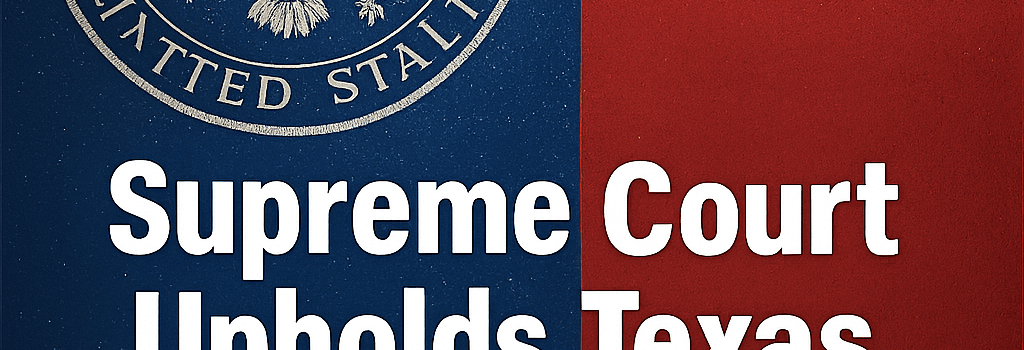Supreme Court Upholds Texas Age-Verification for Adult Sites

The US Supreme Court’s 6–3 decision on June 27, 2025, upholds Texas’s landmark House Bill 1181, requiring online pornographic platforms to verify user age before granting access. The ruling, delivered by Justice Clarence Thomas, has far-reaching implications not only for First Amendment jurisprudence but also for web developers, cybersecurity teams, and privacy advocates.
Background of the Case
Texas enacted HB 1181 in response to widespread concerns about minor exposure to sexually explicit content online. The Free Speech Coalition, representing major adult-industry players, challenged the law as an impermissible restraint on adult free speech. Pornhub preemptively disabled its site in Texas rather than implement the mandated government-issued ID or transactional data checks.
The Supreme Court’s Ruling
Applying intermediate scrutiny, the majority held that:
- The law advances a significant government interest in protecting minors.
- Age verification is an established, tailored method—long used in physical adult venues—that translates to the online context.
- Adults have no constitutional right to access sexually explicit content without first proving their age.
Justice Thomas wrote that HB 1181 “advances important governmental interests unrelated to the suppression of free speech and does not burden substantially more speech than necessary to further those interests.”
Key Legal Findings
- Intermediate Scrutiny Standard applies because the law only incidentally burdens adult speech.
- Digital vs. Physical Access are analogous; requiring ID online mirrors in-person checks at adult bookstores or theaters.
- Tailoring and Underinclusiveness are permissible; the state need not adopt the least restrictive means.
Dissenting Views
Justice Elena Kagan, joined by Justices Sotomayor and Jackson, argued for strict scrutiny, contending that HB 1181 directly regulates speech by content and imposes a cost on adults seeking lawful expression. She emphasized the privacy risks in uploading IDs or sharing transactional data, warning of data breaches and unauthorized tracking.
Kagan wrote that the requirement “deters the exercise of protected speech by exposing users to privacy invasions and potential misuse of sensitive data.”
Technical Implementation and Challenges
Web operators must integrate one of two principal verification methods:
- Government-Issued ID Scanning using OCR and liveness detection, often via third-party KYC (Know Your Customer) providers.
- Transactional Data Verification leveraging credit bureau APIs or banking networks to confirm age and identity.
These solutions introduce complex technical requirements:
- Secure data transmission over TLS 1.3 or higher.
- Encrypted storage, ideally using AES-256 and hardware security modules (HSMs).
- Data retention policies limited to the minimum necessary window (30–90 days) before automatic deletion.
- Regular security audits and compliance with standards such as ISO 27001 or SOC 2.
Privacy and Data Security Risks
Collecting IDs or financial data at scale elevates risk:
- Data Breach Exposure: In 2024, global data breaches increased by 20%, with personal identification data being the most lucrative target.
- User Anonymity: Age verification conflicts with the long-standing norm of anonymous browsing in the adult industry.
- Compliance Burden: Small and specialty sites face steep integration costs, estimated at $50,000–$150,000 for initial setup and $10,000 per year for audits.
Expert Opinion: Dr. Elena Petrova, a cybersecurity researcher at the Internet Policy Institute, warns that “mandating centralized data repositories for sensitive ID information creates honeypots for attackers.” She advocates for zero-knowledge proofs or blockchain-based age tokens to validate age without revealing underlying data.
Alternative Age-Verification Solutions
Emerging technologies aim to reduce privacy impacts:
- Zero-Knowledge Proofs (ZKP): Cryptographic protocols that confirm a user is over 18 without disclosing exact birthdate or ID images.
- Mobile Driver License (mDL) Standards: ISO 18013-5 allows users to share only age verification flags from a digital license stored on a smartphone.
- AI-Driven Age Estimation: Computer vision models that predict age range from a live camera feed, though accuracy and bias remain concerns.
Comparative Regulatory Landscape
Several jurisdictions are enacting similar measures:
- European Union: The Digital Services Act requires “trusted flaggers” and age-gates but emphasizes data minimization under GDPR.
- United Kingdom: Draft Online Safety Bill contemplates age verification for adult content, with fines up to 10% of global turnover for non-compliant platforms.
- Florida and Utah: Both states have proposed or passed bills mirroring Texas’s approach, with civil fines and potential injunctions.
Reactions and Next Steps
Electronic Frontier Foundation decries the decision as a “blow to adult expression and privacy,” pledging to support future challenges focusing on non-sexual age limits.
Texas Attorney General Ken Paxton lauds the ruling as a “major victory,” warning that violations could incur fines up to $10,000 per day and $250,000 if minors gain access.
Conclusion
The Supreme Court’s decision cements a new era of state-level regulation over online adult content, demanding robust age‐verification systems and heightened data security measures. As platforms scramble to comply, emerging privacy‐preserving technologies offer a path forward. Stakeholders across web development, cybersecurity, and digital rights advocacy will watch closely as challenges to HB 1181 and similar laws progress through the courts.